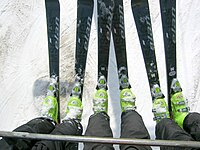Elan SCX

Elan skis derived from the SCX design
|
|
| Inventor | Jurij Franko and Pavel Škofic |
|---|---|
| Inception | 1993/4 |
| Manufacturer | Elan |
The SCX, for "SideCut eXtreme" (or "eXperiment"), was an alpine ski introduced by Elan in the winter of 1993/4. Skis before the SCX had almost always used a shape that was slightly curved inward on the sides, typically by 7 mm compared to a straight line. The SCX was designed with over 22 mm "sidecut", producing a wasp-waisted ski unlike anything on the market.
The SCX proved to dramatically improve turn performance and made it much easier to perform the efficient carve turn. This led to higher speeds in giant slalom, and the ski started winning race after race when it was introduced. It also made skiing easier in general, and revolutionized ski schools, especially in the US where the design first caught on. By 1996 every major ski company was racing to introduce similar designs, and traditional designs were being sold off for pennies on the dollar.
As the first successful "shaped" or "parabolic" ski, the SCX is considered one of the most important advances in the history of the sport.
The first true downhill skis, made in Telemark, Norway by Sondre Norheim, were handmade from single pieces of hardwood and featured a relatively modest sidecut of about 4 to 5 mm. Alpine ski development after this seminal introduction proceeded in a series of stepwise improvements; laminate woods, metal edges, metal laminates (see the article on Howard Head) and finally the fibreglass torsion box design were introduced over a period of 100 years. Throughout, little engineering effort had been spent on considering the ski shape, as other issues like torsional stiffness and "chattering" were problems that needed to be solved. Skis of the 1970s were largely identical in shape to those of the 1800s.
Skis with narrower waist profiles had been experimented with, but had never become widely used. In 1939, Dick Durrance ordered a custom ski from Thor Groswold's factory in Denver with a 7 mm sidecut, and this became a new standard for slalom skis. During the winter of 1948/49, Jerry Hiatt and Thor's son Jerry decided to experiment with even bigger sidecuts. Taking a pair of the company's standard hickory Rocket skis, they cut away wood until they produced a 15 mm sidecut. When they tried them out, they found they turned quite easily in a series of rounded turns. Ironically, this was considered poor form in the era of the stem Christie, where good form was a series of sharp J-shaped turns. The two abandoned the design, speculating that they ended up as firewood.
...
Wikipedia
